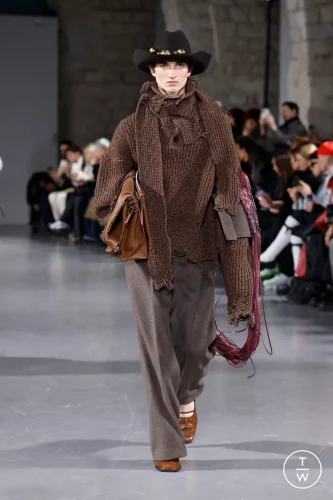











Dear Shaded viewers,
The name of Sean Suen’s FW25 collection, ‘Xiang’, translates to ‘noble horse’ and stands for the relentless charge of revolution. An amalgamation of cultural references, the collection pays tribute to the Ancient Tea Horse Road, the great trade route that once connected Qinghai to Tibet by winding through the mountains of Southwestern China. Over centuries traders of tea silk, safflowers, and cordyceps permanently carved a path at times no wider than a foot into the land.
Sean Suen is known for his ability to infuse contemporary fashion with his own heritage and historical depth and achieves this once again in Xiang. This season, his design inspiration was from the horsemen of the Tang and Song dynasties interwoven with elements of the Western cowboy aesthetic – without slipping into cliché. Silhouettes are grand and expansive, exuding fluid movement and stoic energy. Pants are reminiscent of chaps and the slit skirts of Ancient Chinese riders in their structure, while funnel sleeve coats, trenches, shearling jackets, and ponchos feature oversized lapels and pockets. Sharp, angular cuts and precise tailoring enhance an air of impenetrable mystery.
The collection’s earthy palette reflects the landscape of the Ancient Tea Horse Road in the Fall/Winter season: deep sienna, rich woody brows, and golden yellows layered over cool, dusty greys and blacks. The restrained colour scheme guides the focus towards the intricate craftsmanship and detailing of each garment. Large bells punctuating outerwear echo the clinking spurs and long pony hair accessories hang and sway, further embedding the horse motif. The interplay of textures advances the garments into the future, with distressed wools, innovative leather weaving techniques, and fur accents emphasising adaptability and resilience – essential virtues for the men who dared take on the Ancient Tea Horse Road.
In FW25, Sean Suen turns another page in his ongoing exploration of cultural heritage, offering a compelling lesson in history through fashion. His garments remain relevant and refreshing in our time, proving that fashion can be a bridge between time and culture.
Later,
Eliya



